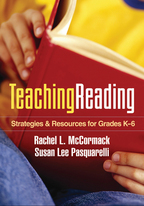Teaching Reading
Strategies and Resources for Grades K-6
Rachel L. McCormack and Susan Lee Pasquarelli
2. Creating a Literacy-Rich Classroom Environment
3. Developing Foundations for Fluent Readers: Phonological/Phonemic Awareness, Phonics, and Fluency
4. Cultivating Children’s Curiosity for Words: Teaching Vocabulary
5. Preparing Strategic Readers: Teaching Reading through Cognitive Strategy Instruction
6. Helping Children to Construct Meaning: “Good-Reader” Comprehension Strategies
7. Teaching Expository Text across the Curriculum
8. Appreciating Children’s Literature: Teaching the Language of Narrative Text
9. Supporting Children’s Voices: Response to Literature through Writing
10. Creating a Culturally Responsive Classroom Community
11. Assessing Children’s Reading Development: Part 1. Motivation, Phonological/Phonemic Awareness, Word Identification, and Fluency
12. Assessing Children’s Reading Development: Part 2. Vocabulary, Comprehension, and Reader Response
13. Viewing Ourselves as Professional Teachers of Reading
Appendix A. The Most Common Phonetic Elements and the Most Common Onsets and Rimes
Appendix B. Second-Grade Sample Reading Performance Assessment



